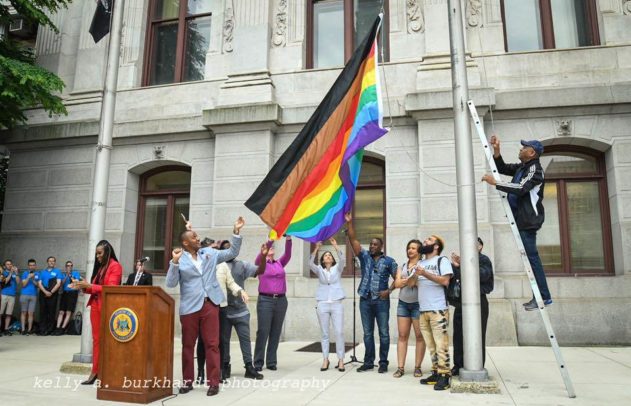This blatant white-washing of an issue is exactly the reason why we need the change: So queer POC like myself no longer feel like we are sitting on the outside of a group that is supposed to make us feel safe.
The Pride flag is something that is globally known as a unifying symbol for the LGBTQ+ Community. While the queer community has historically prided itself on loving and accepting all of those who identify as such, the reality is that many queer people, primarily queer people of color (POC), are discriminated against by the greater queer community.
This year, the city of Philadelphia added a black and brown stripe to the flag to show not only solidarity with POC members, but also to show their unique struggles and their extraordinary contributions to the fight for equality. Reverend Irene Monroe, a long-time civil rights advocate explained why adding the bars is an essential step toward true equality, stating that, “Those black and brown LGBTQ people [who were the pivotal leaders of the Stonewall Riot] are not only absent from the photos of that night, but have been bleached from its written history.”
Reverend Morgan is correct; while most people are celebrating the inclusion of the most marginalized queer people, there are others within the community, particularly cisgender white gay men, who immediately began crying out in outrage. They complained that Pride was about everyone, and adding bars for race was unnecessary. Even friends of mine said, “You don’t see a white stripe on there, do you?” and “If we were so racist, why would we associate with people of other races?”
This blatant white-washing of an issue is exactly the reason why we need the change: So queer POC like myself no longer feel like we are sitting on the outside of a group that is supposed to make us feel safe.
*****
“You’re so lucky to be so many different things.” That is a sentence I have heard a hundred times in my life. Never one destined to fit in a mold, I have always found myself standing slightly outside of the circle. From being the biracial daughter of the blonde-haired blue-eyed mother and equally Caucasian father who was born without an eye, to coming out three separate times, as bisexual, then a lesbian, and most recently a transgender man who is, yes, still as bisexual as his childhood self thought he was.
For the majority of my life I was both the only person of color and the only queer person in my group of friends. Thankfully, adulthood happened and I am now surrounded by a group of charismatic and hilarious like-minded queers with one striking exception; I am still the “token” POC in the group, and I still find myself looking in from the outside at times.
Coming out is never easy, but the minority queer population has even more stacked against them. And once we are all out and supposedly on the same team, those of us who do not fit the archetype (white, upper-middle class background, attractive, and educated) of what being “queer” is, we find ourselves thrust into a brand new cage, shunned by those who are supposed to be opening their hearts and minds to us.
As much as Queer America wishes to pride ourselves on being an inclusive community, the reality is being a queer POC is still seen as such a misnomer within the greater group as a whole. We as both queer people and POC feel like we are torn at both ends, struggling to fit in a racial community and the queer community.
While Pride is supposed to be a celebration for the entire queer population, POC and those of a non-conforming gender often find themselves left out of a party that is just as much for them as it is for the Nick Jonas-esque gay men.
I personally have been called both a “tranny” and a “he-she” by cisgender gay white men.
The idea that one can be gay and prejudiced is something that no one wants to admit. But being non-heterosexual does not have anything do with one’s racial bias.
The Pride flag is not just the gay pride flag, or the lesbian pride flag, it is the entire queer community’s flag. And just like no one was taking away the rights of straight couples when we fought so valiantly for marriage equality, we need to lift up everyone in our beautiful umbrella of a community. And that is what the addition of the brown and black bars is meant to represent. We need to be lifting up queer POC, helping them celebrate all of what makes being a queer person such an amazing thing. Because we cannot afford to forget that equality for one group means equality for all.
Asher Kennedy is a chef and freelance writer living about an hour outside of Washington D.C in Eastern West Virginia.
Other Links:

